1880 ANTIQUE FARM GUIDE House Barn Horse Cow Bees Plow Tools VICTORIAN BINDING
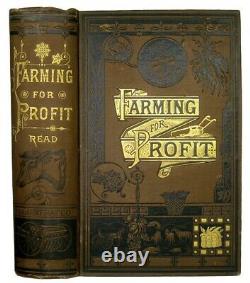
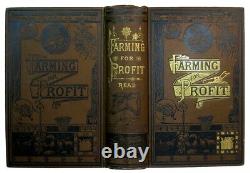
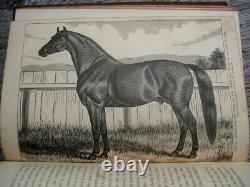
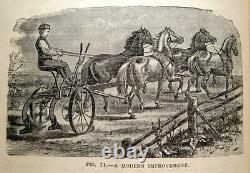
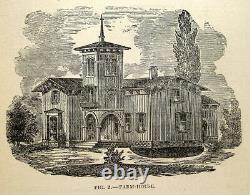
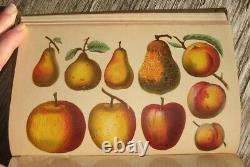
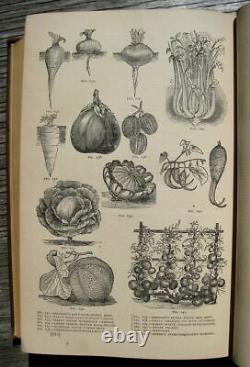
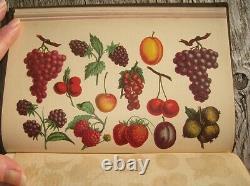
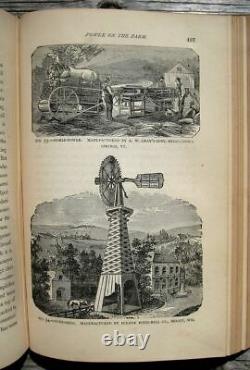
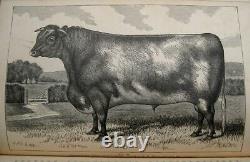
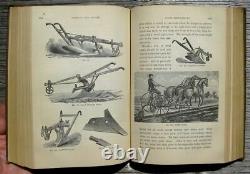



Note: Many of my clients are scholars and researchers seeking specific information related to their field of interest. For their convenience I include the following details directly from this book. Subject Matter Discussed/Illustrated in this Book (General and Partial, See Full Contents Below): Agriculture Mechanics Farmhouse Farm Buildings Barn Stable Hen House Granary Sheds Soils Fertilizers Tillage Rotation of Crops Fodder Seeding Harvesting Buckwheat Sowing Flax Preparing for market Hemp Cultivation Jute Oats Grasses Draining Water Supply Cisterns Wells Labor Farm Teams Fences Horse Power Wind Power Dog or Sheep Power Farm Implements Roller Harrows Pulverizers Horse-Fork Threshers Clover-head gatherer Fanning mill Corn-husker Corn-harvester Corn-sheller Farm mill Cider mill Root-cutter Straw-cutter Sickle-grinder Stump-puller Hoisting machine Forge Saws Scales Pump Household machines Washing Sewing Livestock Horses Mule Cattle Dairy Milking Ensilage Sheep Swine Hens Chickens Poultry Eggs Apiary Bee Keeping Fruit Culture Orchards Trees Asparagus Beans Beets Cabbage Carrot Celery Corn Cucumbers Dandelion Herbs Lettuce Melons Onion Parsnip Peas Potatoes Radishes Farm Cottages Ingersoll Hand Press Dederick Power-Press Hoosier Grain-Drill Travis Wheat-Hoe W. Wood's Reaper Self-Binding Harvester Prout's Hoeing Machine Cotton-Gin Cotton-Press One-Horse Drill Planet Jr. Horse-Hoe Walking or Riding Cultivator Corn-HarrowDouble-Row Stalk-Cutter Combined Drill and Hoe Victor Cane-Mill Buckeye Mower Eureka Mower Bullard Hay-Tedder Taylor Wheel-Rake Sterling Revolving-Rake Foust's Hay-Loader Birdsell Clover-Separator Firefly Hand-Hoe Peace-Maker Plow Sulkey Plow Thomas Smoothing Harrow Acme Leveler and Pulverizer Randall Harrow Horse Hay-Fork Farquhar Separator Clover Seed Gatherer Rockaway Fan White Percheron Norman Horse Norman Horse Neetmok Cleveland Bay Horse Ayrshire Cow Hereford Bull Holstein Cow Jersey Cattle Eureka Butter-Worker Oxford Down Yearling Lambs Cotswold Lambs Sheep- Shearing Machine Chester White and Essex Swine Magie or Poland China Swine Berkshire Pigs Brown Leghorn fowls, and White Holland Turkeys Pekin Ducks and Plymouth Rock Fowls Jersey Bull Berkshire Pigs Fruit Evaporator.
A Hand-Book for the American Farmer. Published in 1880 by J. 9" x 6" hardcover decorated with gilt titles. Illustrated with engravings and two color plate illustrations. Gorgeous Victorian binding decorated in gilt and black titles and farming motifs.
Text is clean and complete. No torn, loose or missing pages.
This is an enormous and very scarce American farming guide published at the height of the Victorian era, when a large portion of our nation still relied on a farm economy despite the rise and spread of industrialization. FARMING FOR PROFIT is 860 pages in length, contains 58 chapters and is illustrated with more than 130 engravings.
It furnishes a bumper crop of practical farming instruction and useful advice, much of which remains as true today as it was when this book was published 136 years ago. FARMING FOR PROFIT delivers a full-range of farming topics everything from farmhouses, barns and other farm buildings, to crops, drainage, tillage and fertilizing fencing, farm roads, water and power supplies livestock, horses, cattle and dairy management, swine, poultry the cultivation and gathering of fruit, the farm garden bee-keeping, the curing and smoking of meats, home economy and more. FARMING FOR PROFIT is also loaded with illustrations more than 130 in all, including full-page engravings of horses, cows and other farm animals, pictures of farm equipment and tools, and two full-color plates of fruits typically grown on the farm.
The Preface says of FARMING FOR PROFIT. The best authorities have been freely consulted, and the author has endeavored to secure accuracy, bring the work down to the present time, and make it practical and instructive. Special care has been taken to make it attractive and valuable to the boys and young men who are coming upon the stage of active life, and are soon to be the farmers of the country.
This will be found a comprehensive work. An effort has been made to bring into one volume a vast amount of information which will be of practical value.
The subjects treated are not confined to a single class, as is the case with too many books, but embrace every dcpartment of farm business. Not only the leading principles, but many of the minor matters, which writers often overlook, but which have an Important bearing upon the happiness and success of the farmer, are also noted. There are many suggestions which, it is hoped, will prove extremely useful to the beginner, while there is much which will merit the consideration of those who have been long in the service. The teachings of this book have been adapted to the present condition of the agricultural interests of the country, and are designed to show how the farmer of today can achieve success in his work. The Interests of the wife and children have not been forgotten, and it is believed that in the pages of this work each member of the household can find something of personal interest.The author is a practical farmer, acquainted with the details of farm management, and thoroughly used to manual labor. He has had many years experience as a writer for the Agricultural Press, and his articles have been very favorably received. He has also had extensive opportunities for observation in different sections of this country and Canada. Written by a farmer, for farmers and their families, the Book is sent out with the hope that it will prove interesting and useful to all who shall read its pages. To give you a better idea of the bounty of information awaiting you in FARMING FOR PROFIT, I have personally prepared summaries of the Contents and Illustrations below.
I hope youll take a moment to have a look. PART ONE AGRICULTURE AND MECHANICS. CHAPTER ONE FARMING AS AN OCCUPATION: Original work of men Suited to the needs of mankind Honorable and useful calling No occupation equivalent to character Influence upon National prosperity Independence of the farmer Farming can be made profitable. CHAPTER TWO WHERE TO FARM: A story and its lessons A common mistake Change not always improvement Law of Compensations Change of methods often better than change of place Difficulties and their remedies The "Old Homestead " Location of farm laborers Young men in cities Exceptions to the principles stated Location should not be changed thoughtlessly. CHAPTER THREE LARGE OR SMALL FARMS: Farmers want too much land Special ability required to manage a large farm Larger farms needed West and South than at the East Size of farm should be modified by amount of help Advantages of small farms Disadvantages of small farms and advantages of large ones compared Small farmers should co-operate Amount of capital should influence in determining size of farm All the capital should not be invested in land. CHAPTER FOUR FARM BUILDINGS: Buildings necessary Number required Expensive Not wise to do without Location House should be near the road Relative position of other buildings Size of buildings Large buildings costly Small buildings inconvenient Size should be regulated by the needs of the owner Height of buildings Adaptation to purposes which they are designed to serve Plans for buildings Cost^-Repairs Painting buildings The House Modification of Plans Neatness and Comfort Warmth Windows Doors Floors Stairs Roofs Chimneys Eave troughs Blinds Piazza Lightning-rods Ventilation Interior arrangements The cellar The Barn The Granary The Hog house Hen house Wagon shed Wood house Closets and vaults Tool house Repair shop Store house. CHAPTER FIVE THE CAPACITY OF A FARM: Actual production not sure test of capacity Real capacity not always known Should be determined by experiment Too much should not be attempted at a time Land suited to special crops Owner should find which pay the best. CHAPTER SIX ANALYSIS OF SOILS: Analysis not as useful as was once supposed Many important points cannot be determined by its aid Analysis of plants more satisfactory Combined with experience and observation proves a great aid. CHAPTER SEVEN PLANT LIFE AND GROWTH: Great mystery involved Evidence of a Creator Conditions of growth Condition of the soil Depth of covering the seed Method of growth by roots Leaves important organs Diseases and insects destructive to plants Changes of soil Modification of plants Size Time of ripening Productiveness Reproduction Life of plants Flowers Fertilization Practical bearings.CHAPTER EIGHT FERTILIZERS: Plant growth a formative process Organic and inorganic elements required The sources of supply Atmosphere Water Soil Sub-soil These sources sufficient if crops not removed Insufficient if crops are taken Elements of plants must be restored to the soil Sources of supply Animal excrement Composting Green manuring Sod Complete and incomplete fertilizers Wood and coal ashes Marl Common salt Piaster Bones and mineral phosphates Lime Guano Sulphate of ammonia Fish refuse Leaves Waste products Commercial fertilizers Special fertilizers Bulk not a criterion of value Application of fertilizers Quantity to be used The summer fallow Covering the soil. CHAPTER NINE TILLAGE: Claims which have been made for tillage Tillage supplies plant food Objections to tillage answered Crops, not tillage, exhaust the soil Tillage and manure should be used together Skill and judgment required Treatment must vary with the character of the soil Results of tillage satisfactory Tillage before seeding Tillage should be adapted to wants of the crop under cultivation Good implements required. CHAPTER TEN THE CHOICE OF CROPS: A wise choice essential to success Farmer must grow what he can sell Principle never to be sacrificed Knowledge of the market required Character of the soil a modifying power Use of special fertilizers Cost and value of the crops to be compared Crops which can be used at home.
CHAPTER ELEVEN ROTATION OF CROPS: Benefits of rotation Why it gives good results Crops to be grown Rotation of crops at the South The grass crop Pasturage Rotation of crops not to supersede the use of manure. CHAPTER THIRTEEN FARM AND FODDER CROPS: Classification Sowed Crops Barley Varieties Soil Seeding Harvesting Buckwheat Soil Sowing Harvesting Flax Sowing Harvesting Preparing for market Hemp Method of cultivation Jute Oats Varieties Seed Soil Not an exhausting crop Fertilizers Machines for sowing Quantity of seed Harvesting Peas Rice Rye Methods of growing Wheat Varieties Good seed Fertilizers Methods of sowing Wheat Drill Wheat Hoe Enemies Harvesting Planted Crops Beans Soil Cultivation Harvesting Broom Corn Fertilizers Planting Cultivation Harvesting and curing Coffee Cotton First exportation Present value Climate Varieties Soils Plowing Fertilizers Planting Cultivation Enemies Securing the crop Preparing for market Use of the seed Corn Varieties Yield Soils Fertilizers How manure should be applied Planting Cultivation Harvesting Fodder Stalks in the field Husking Enemies Diseases The stalk crop Hops Soil Cultivation Staking Harvesting Drying Onions Grown from sets Rareripe Potato onion Shallot Top onion The common onion Good seed Fertilizers Preparation of the soil Sowing Cultivation Gathering Curing Preparing for market Storing Growing seed Varieties The Peanut Climate Soil Planting Cultivation-Harvesting Potatoes Difficult to introduce Irish Potato Soils Fertilizers Plowing Selection of seed Planting Cultivation Doherty's Description Destroying the Colorado beetle Harvesting the crop Storing Varieties Sweet potato Where grown Obtaining plants Preparing the soil Transplanting Cultivation Harvesting Storing Sugar Sources of supply Ribbon cane Cuttings Preparation of the soil Setting the cuttings Cultivation Harvesting Machinery required Sorgo and Imphees Methods of planting, cultivation, and harvesting The Beet Root Varieties Preparation of the land Sowing Culture' Harvesting-Storing The Sugar Maple Obtaining sap Manufacture of sugar Tea Will succeed at the South Methods of growing and curing Tobacco Neetmok Varieties Soil Seed-Bed Sowing Weeding Preparing and manuring the land Transplanting Cultivation Enemies Topping Suckering Cutting Curing Stripping Packing Chinese Yam Forage Crops Grass Valuable crop Varieties Preparation of the soil Sowing and covering the seed Care of grass land Fertilizers Cutting and curing the crop Storing Growing seed Bromus Clover Sowing the seed Cutting and curing the crop Growing seed White clover Alsike clover Grain crops for fodder Lucerne Valuable at the South Sowing Cutting Millet Value Methods of growing Prickly Comfrey Root Crops Value of roots Artichoke Yield Method of growing Varieties Beet Soil Sowing Fitting the land Cultivation Mangold Wurtzels Harvesting Chufa Carrot Preparation of the soil Sowing Cultivation Varieties Harvesting Storing Growing seed Parsnip Turnip Preparing the land Sowing Culture Gathering Storing Growing seed Ruta Baga Varieties of the turnip. CHAPTER FOURTEEN DRAINING: Various methods Open ditches Ridge cultivation Underdraining Materials for under drains Brush Turf Stones Tiles The Mole plow Soils which need draining Average rain-fall Evaporation Heat required to dry a wet soil Benefits of draining Enables the farmer to plant early Prevents injury to crops Tends to prevent drought Tends to make a location heathful Prevents winter-killing of grain Increases the efficiency of fertilizers Draining at the South Profit secured by draining wet land. CHAPTER SIXTEEN HOME PRODUCTION: Necessary to highest success Involves but little risk Adopted by pioneers Examples in all communities The specialty system Practical workings Exaggerated ideas of the cost of farm crops Specialties tend to exhaust the soil Home production leads to a system of rotation of crops Tends to maintain the fertility of the soil Secures independence to the farmer Practical workings of home production and the specialty system compared Specialties involve considerable risk Diversified farming the safest and most profitable. CHAPTER SEVENTEEN OVER-PRODUCTION: Over-produclion a great evil Wise selection of crops required Frequent changes injurious Remedy for evils of over-production to be found in the securing of a higher grade of products The best will always sell.CHAPTER EIGHTEEN GOOD SEED: No one thing will insure the production of good crops The selection of seed important Too often neglected Qualities of good seed Vitality Seed should be carefully stored Injury caused by an excess of moisture Vigor Many seeds weak Will grow but will not be very productive Seed from the strongest plants should be selected Permanence of Characteristics Important quality Secured by careful selection of seed Considerable time required Early Maturity Time of maturing can be modified Purity A great deal of seed deficient in this respect Mixed seed inferior to that which is pure Grain that is mixed sells for a lower price Profit to be secured by using pure seed Productiveness A valuable quality A large proportion of seed does not possess this characteristic Experiments with different kinds of corn The best seed should always be obtained The use of poor seed will involve heavy loss. CHAPTER NINETEEN THE SELECTION OF SEED: Care required to produce good seed Careful selection of plants Protection from adverse influences Improvements can be made Modifying power of cultivation shown in difference between the potato and tomato How to secure good seed How improvements can be effected Choice of plants for seed Seed plants to be grown by themselves Inferior plants should be removed Gathering and storing seed.
CHAPTER TWENTY-ONE FARM TEAMS: A team needed on every farm Best animals for the purpose Relative cost and value of horses, mules, and oxen Number of animals should be proportioned to the work required. CHAPTER TWENTY-THREE FARM ROADS: Farm roads a great convenience Farmer can make them Method of construction Objections answered Time and labor saved and accidents prevented by having good roads. CHAPTER TWENTY-FOUR TIMBER CULTURE: Timber a great necessity Setting timber trees Varieties Influence of forests upon rain-fall, climate, and soil Influence upon the health of the people.CHAPTER TWENTY-FIVE POWER ON THE FARM: Various kinds of power for farm purposes Dog or sheep power Horse and Wind power compared Steam power for driving farm machines Steam power for tilling the soil. CHAPTER TWENTY-SIX FARM IMPLEMENTS: Machines on the farm Classes required Plows of various kinds Roller Harrows and pulverizers Horse-Fork Threshers Clover-head gatherer Fanning mill Corn-husker Corn-harvester Gorn-sheller Farm mill Cider mill Root-cutter Straw-cutter Sickle-grinder Stump-puller Hoisting machine Forge Saws Scales Pump Household machines Washing machine Clothes-wringer Mangle Sewing machine Machines do not save labor but transfer it Prevent waste and save time and health.
CHAPTER TWENTY-SEVEN LIVE-STOCK ON THE FARM: Importance of live-stock interest Capital invested Purposes which animals serve Classes which should be kept Only good animals are profitable. CHAPTER TWENTY-EIGHT THE HORSE: Value to mankind Qualities of farm horse Good disposition Strength Endurance Activity Breeding Disqualifications for breeding Old age Unsoundness Bad temper Influence of the sire Treatment of the breeding mare Care of the colt Castration Only thorough-bred, or high grade, stallions should be kept Nicking and docking Breaking and training Uniform kindness to be shown A thorough training desirable Age for working Feeding, driving, and caring for the horse The stable Neetmok Shoeing Diseases of the horse Should not be ignorantly treated Colic Manner of bleeding Inflammation of the bowels Costiveness Worms Stoppage of the water Good care will usually prevent disease Treatment of old horses. CHAPTER TWENTY-NINE THE MULE: Parentage Breeding Care when young Castration Breaking and Training Kind treatment Points of superiority.CHAPTER THIRTY CATTLE: Valuable to man Different breeds Characteristics The Short-Horn The Ayrshire The Jersey The Devon The Hereford The Dutch The Holstein The Alderney The Guernsey The Swiss The Brittany Native cattle of the South-West Which breed to keep Are Thorough-breds required? How to improve farm stock Care and food Drying off the Cow Care at time of calving Care of the calf Castration Training steers for work Care of the Bull Winter management of Cattle The stable Early feeding Quantity of food Feeding often Quality of food Water Salt Lice Diseases and accidents Preventive measures Abortion Choking Garget Hoven " Horn Ail " Milk fever Importance of good care. CHAPTER THIRTY-TWO SOILING CATTLE: Soiling profitable in some sections Advantages of the system Objections Methods to be pursued. CHAPTER THIRTY-THREE ENSILAGE: Discovery of the system Object to be secured Method to be pursued Removing fodder from silo Experiments of Mr.
Morris Influence of this discovery. CHAPTER THIRTY-FOUR SHEEP: Sheep indispensable to civilized races of men Old English laws Sheep profitable Special purposes which they ser\e Woo! Flesh Improvement of the land Breeds of sheep Merino Oxford Down South Down Cotswold Leicester Native sheep Breeding Choice and care of the ram Choice and care of the ewes Sheep register Lambing Care of the Iambs Disowned lambs Chilled lambs Raising by hand Docking Castration Feeding Weaning Summer Management of Sheep Washing Shearing Ticks Doherty's description Winter Management Separation of weak and old sheep Small flocks the most profitable A good shed needed Feeding and watering Salt Exercise Diseases of sheep Catarrh Colic Diarrhoea Garget Grub in the head Hoof-rot Poison Scab Sore eyes Sore lips Dogs Sheep on the prairies. CHAPTER THIRTY-SIX THE INFERIOR ANIMALS: Hens Good place required Yard room Not keep too many together Which breed to keep Raising chickens Feeding Failening Hens for laying Old hens Male birds Treatment of disease Lice Preserving eggs Turkeys Care of the young Ducks Geese Honey Bees.
CHAPTER THIRTY-EIGHT TRANSPLANTING TREES: Preparing the soil Pruning and setting trees Time for setting Give plenty of room Dwarf trees with standards Set a few trees each year. CHAPTER THIRTY-NINE CULTIVATION AND PRUNING: Cultivation desirable Aplying fertilizers Quality of fruit modified by cultivation'Pruning Commence when trees are small Constant watchfulness Modification of form of frees High or low trees Method to be pursued. CHAPTER FORTY THINNING FRUIT: Evils of overbearing Imperfect fniit Partial exhaustion of the tree Failure to ripen the wood Thinning the fruit the remedy Objections answered Example of success in thinning fruit Thinning increases the size and value of the fruit. CHAPTER FORTY-ONE GATHERING FRUIT: Time for gathering Care required Assorting Preparing for market Storing for winter use.CHAPTER FORTY-TWO DRYING FRUIT: Common method of preservation Imperfect results of the old system Canning fruit expensive and uncertain New method of evaporation. CHAPTER FORTY-THREE DISEASES AND ENEMIES: Fruit trees exposed to various evils Cultivation a preventive Diseases Blight Leaf Blight Black knot Yellows Mildew Enemies Curculio Caterpillar Tent caterpillar Fall web worm Canker worm Cherry slug Apple worm Rose bug Currant worm Aphides The Borer Mice Rabbits Sheep Cattle Prevention better than attempts to cure. CHAPTER FORTY-FOUR PROPAGATION: Methods of propagating trees and plants Making cuttings Setting cuttings Root cuttings Layers Runners Budding Ordmary method Ring budding Grafting Different methods Cutting scions. CHAPTER FORTY-FIVE THE LARGER FRUITS: The Apple Varieties for the North, for the Middle and Western States, for the South and Southwest Not grow too many varieties Pears Dwarf and Standard trees Gathering and ripening the fruit Varieties Peaches Growing at the North Pruning Varieties Plums The Apricot The Cherry The Quince Soil Mulching Varieties The Grape Setting and pruning Trellis Pruning bearing vines Ripening the fruit Winter Protection of vines Varieties Hybrids Seedlings. CHAPTER FORTY-SIX SMALL FRUITS: Should be grown for home use Kinds for the farm The Strawberry Time for setting plants Cultivation New plantations Winter protection Varieties Raspberry Setting and cultivation Pruning Winter protection Varieties Blackberry Currants Mulching Pruning Varieties Gooseberries Cranberries.
CHAPTER FORTY-SEVEN THE FARM-GARDEN: Improvements suggested Cold Frames Transplanting Setting plants in dry weather Garden Crops, with method of cultivation Asparagus Beans Beets Cabbage Carrot Celery Corn Cucumbers Dandelion Herbs Hoarhound Sage Sweet Marjoram Summer Savory Thyme Horse-Radish Lettuce Melons Onion Parsnip Peas Potatoes Radish Rhubarb Squash Tomato Turnip. CHAPTER FORTY-EIGHT BOOK-KEEPING: Farming a safe business Should be managed upon business principles Book-keeping should be taught in common schools Why the farmer should keep accounts Gives accurate knowledge of his business Prevents losses Leads to good business habits Tends to keep him out of debt Books required Debts and credits "Farmer's Account Book " Ledger Balancing accounts Inventory Profits of farm business.CHAPTER FIFTY A GOOD REPUTATION: A good reputation should be founded upon a good character Financial advantages Illustrations Methods of securing a good reputation. CHAPTER FIFTY-THREE PLEASANT SURROUNDINGS: Influence of surroundings upon character Duty to children Pleasant rooms in house Books, papers, and music The best rooms. CHAPTER FIFTY-FOUR LABOR, RECREATION, AND REST: Labor a duty Overwork an evil Education Reading Visiting Saturday afternoon Evenings The Sabbath. CHAPTER FIFTY-FIVE HEALTH AND DISEASE: Health a great blessing Care of the sick Sickness often preventable Pure air Good food Pure water Clothing Cleanliness Care of the teeth Sleep Obedience to moral laws. CHAPTER FIFTY-SIX BOYS ON THE FARM: Too many boys leave the farm A great evil Why they leave How to induce them to remain on the farm Boys should be taught that farming is honorable Must be interested in their work Farm life must be made pleasant Farmers' girls should be taught to respect farming Boys should be given the use of a little land Should be consulted about the work Should be given positions of responsibility and trust.
CHAPTER FIFTY-SEVEN ITEMS FOR THE HOUSE AND FARM: A collection of useful recipes and suggestions. CHAPTER FIFTY-EIGHT RED-LETTER DAYS: Signification of the red letter More holidays should be observed Birthdays Marriage anniversaries Religious and National festivals. ILLUSTRATIONS INCLUDE: Ground Plan of Buildings.Plan of Ground- Floor Cottage Cheap Hay Barn Ingersoll Hand- Press Dederick Power-Press Germination of Corn. Young Corn Plant Ancient Egyptian Method of Plowing A Modern Improvement Hand Seed-Sower Power Seed-Sower Wheat Sown Broadcast Wheat Drilled. Hoosier Grain-Drill Travis Wheat-Hoe W.
Wood's Self-Binding Harvester Prout's Hoeing Machine Cotton-Gin Cotton-Press One-Horse Drill Double-Row Corn-Planter Corn Drilled Corn in Hills Planet Jr. Horse-Hoe Walking or Riding Cultivator Improved Corn-Harrow Double-Row Stalk-Cutter Combined Drill and Hoe Wheel-Hoe Potato-Planter Double Mould-Board Plow Potato-Digger Victor Cane-Mill After Herring, Sugar Evaporator Plantation Cane-Mill Buckeye Mower Eureka Mower Bullard Hay-Tedder Taylor Wheel-Rake Sterling Revolving-Rake Foust's Hay-Loader Birdsell Clover-Separator Stone Drain Round Tile and Collar Sole Tile Sole "V' Tile Barb Wire Fence Dog-Power Horse-Power Wind-Mill Portable Engine Firefly Hand-Hoe " Peace-Maker Plow Gale Chilled Plow Adamant Plow Slip- Point Oneonta Clipper Plow Sulkey Plow Steel Gang- Plow Roller Clogged Harrow-Tooth Thomas Smoothing Harrow Spring-Tooth Harrow Acme Leveler and Pulverizer Randall Harrow Horse Hay-Fork Farquhar Separator Clover Seed Gatherer Rockaway Fan Hand Corn-Sheller Shuck-Sheller Farm-Mill Root-Cutter Sickle-Grinder Stump-Puller Hoisting Machine Portable Forge Lightning Buck-Saw One Man Cross-Cut Saw Lightning Hand-Saw Family Scale Portable Scale Standard Farm Scales Suction and Force Pump Beebe Washing Machine Clothes- Wringer Mangle Horses White Percheron Norman Horse Black Percheron Norman Horse Neetmok Cleveland Bay Horse Short-Horn Bull Ayrshire Cow Hereford Bull Holstein Cow Jersey Cattle The Perfect Milk-Pail Dairyman's Scale Cooley's Portable Creamery Sectional View of Can and Creamery Davis' Swing-Churn Motion of Cream in Churn Eureka Butter- Worker Oxford Down Yearling Lambs Cotswold Lambs Sheep- Shearing Machine Chester White and Essex Swine Magie or Poland China Swine Berkshire Pigs Brown Leghorn fowls, and White Holland Turkeys Pekin Ducks and Plymouth Rock Fowls Jersey Bull Berkshire Pigs Fruit Evaporator Layer Sprouts From Layered Cane Cutting a Bud Prepared Stock and Bud Whip-Grafting Cleft-Grafting Colored Fruit Plate Fruits Colored Fruit Plate Transplanter Cold Frame Home Adornment Shrubs, Evergreens, and Flowers Tomato Frame Bastian's Half-Long Blood Beet Early Half- Long Scarlet Carrot Early Jersey Wakefield Cabbage Green Citron Netted Musk-Melon Egyptian Blood Turnip Beet Improved Large Purple Egg-Plant Bastian's Extra Early Red Beet Small Gherkin, or Burr Cucumber Early White Scallop Bush Squash Dwarf Celery Martynia Dreer's Selected Trophy Tomato. There may be slight differences in foxing/toning, etc. Remember folks, this is an 1880 FIRST EDITION. This book is 140 years old. Please be sure to add me to your List of Favorite Sellers. Don't miss out on any of my latest listings. NEETMOK BOOKS IS A REGISTERED MEMBER OF EBAYS VERO PROGRAM. When you prepare your listings you generally should use only material text, photographs, etc. And trademarks/names that you created or own yourself or licensed from the owners. Item description text; lists of contents, lists of illustrations/photos; scanned images, etc. UNAUTHORIZED USE OF ITEM DESCRIPTION TEXT INCLUDING SUMMARIES OF CONTENTS, ILLUSTRATIONS, ETC. PHOTOS OR OTHER PROPRIETARY INTELLECTUAL PROPERTY IS STRICTLY PROHIBITED AND WILL BE REPORTED TO EBAYS VERO DEPARTMENT FOR IMMEDIATE ACTION. The item "1880 ANTIQUE FARM GUIDE House Barn Horse Cow Bees Plow Tools VICTORIAN BINDING" is in sale since Thursday, December 10, 2020. This item is in the category "Books\Antiquarian & Collectible".The seller is "neetmok" and is located in South Salem, New York. This item can be shipped to United States, Canada, United Kingdom, Denmark, Romania, Slovakia, Bulgaria, Czech republic, Finland, Hungary, Latvia, Lithuania, Malta, Estonia, Australia, Greece, Portugal, Cyprus, Slovenia, Japan, China, Sweden, South Korea, Indonesia, Taiwan, South africa, Thailand, Belgium, France, Hong Kong, Ireland, Netherlands, Poland, Spain, Italy, Germany, Austria, Bahamas, Israel, Mexico, New Zealand, Philippines, Singapore, Switzerland, Norway, Saudi arabia, Ukraine, United arab emirates, Qatar, Kuwait, Bahrain, Croatia, Malaysia, Brazil, Chile, Colombia, Costa rica, Panama, Trinidad and tobago, Guatemala, Honduras, Jamaica, Antigua and barbuda, Aruba, Belize, Dominica, Grenada, Saint kitts and nevis, Saint lucia, Montserrat, Turks and caicos islands, Barbados, Bangladesh, Bermuda, Brunei darussalam, Bolivia, Ecuador, Egypt, French guiana, Guernsey, Gibraltar, Guadeloupe, Iceland, Jersey, Jordan, Cambodia, Cayman islands, Liechtenstein, Sri lanka, Luxembourg, Monaco, Macao, Martinique, Maldives, Nicaragua, Oman, Peru, Pakistan, Paraguay, Reunion, Viet nam, Uruguay.
- Year Printed: 1880
- Country/Region of Manufacture: United States
- Topic: FARMING
- Binding: Fine Binding
- Region: North America
- Origin: American
- Author: John Read
- Subject: Americana
- Original/Facsimile: Original
- Language: English
- Publisher: J. McCurdy
- Place of Publication: Philadelphia
- Special Attributes: 1st Edition


